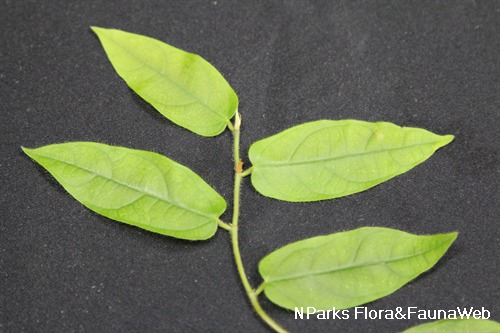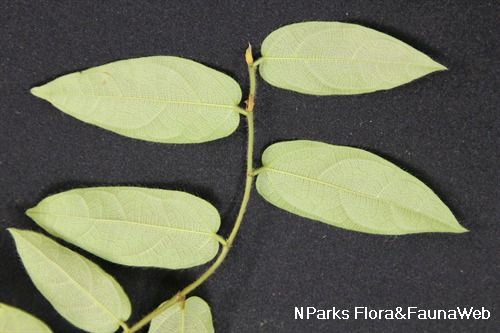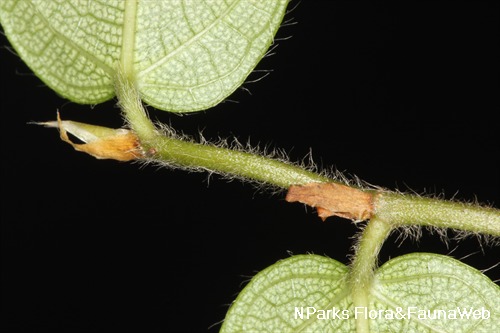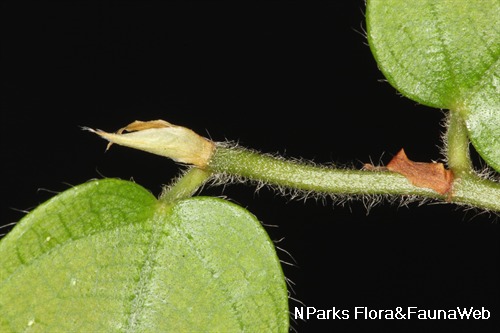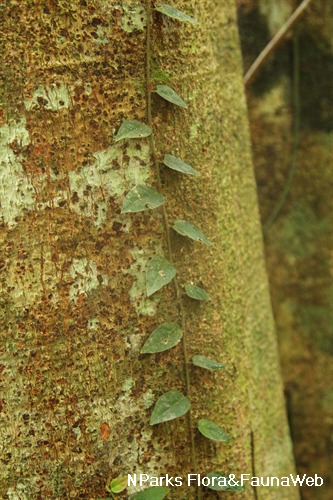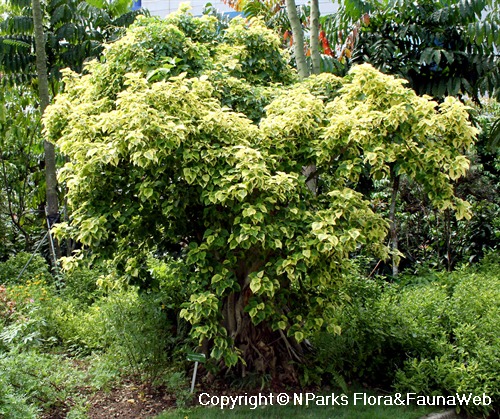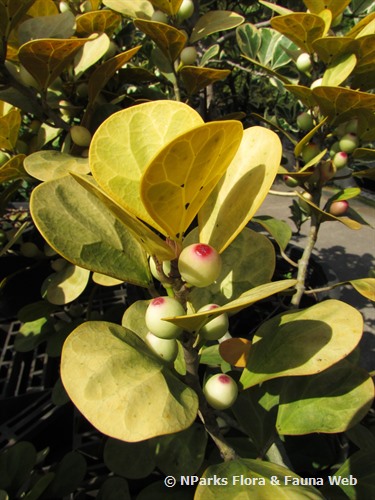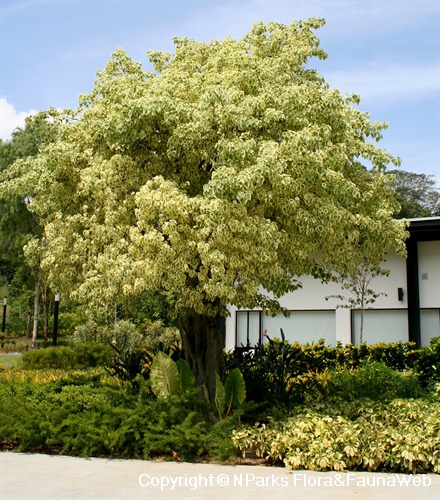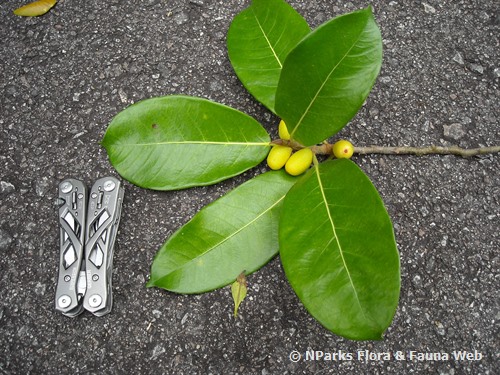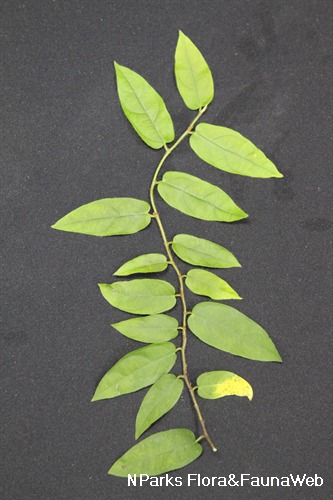
Back
Ficus recurva var. ribesioides (Miq.) King
| Family Name: | Moraceae |
| Synonyms: | Ficus recurva var. ribesoides (Miq.) King |
| Common Name: | Akar dahara |
Name
Classifications and Characteristics
| Plant Division | Angiosperms (Flowering Seed Plants) (Dicotyledon) |
|---|---|
| Plant Growth Form | Climber |
| Lifespan (in Singapore) | Perennial |
| Mode of Nutrition | Autotrophic |
| Plant Shape | Irregular |
| Maximum Height | 4 m |
Biogeography
| Native Distribution | Thailand, Sumatra, Peninsular Malaysia, Singapore, the Philippines, Borneo, and Java |
|---|---|
| Native Habitat | Terrestrial (Primary Rainforest, Mountain, Secondary Rainforest, Freshwater Swamp Forest) |
| Preferred Climate Zone | Tropical |
| Local Conservation Status | Native to Singapore (Critically Endangered (CR)) |
Description and Ethnobotany
| Growth Form | It is an epiphytic root climber. |
|---|---|
| Foliage | Its alternate, stalked leaves have thinly leathery leaf blades that are oval-oblong or rather egg-shaped to lance-shaped, and usually less than 10 cm long. |
| Flowers | The plant is dioecious with each plant bearing male or female flowers. The flowers are tiny and develop within the syconium (fig). |
| Fruit | Its stalked or stalkless syconia (figs) are round, 5–9 mm wide, orange to red when ripe, and develop in pairs or in clusters on the bare portions of twigs behind the leaves, or in the leaf axils. |
| Habitat | It grows on rocks and trees in lowland to lower montane forests, up to 1,600 m altitude. It occurs locally in the Western Catchment area, Jalan Inggu, and the Nee Soon area. |
| Associated Fauna | Its flowers are pollinated by fig wasps. |
| Cultivation | It can be propagated by seed or stem cuttings. |
| Etymology | Latin Ficus, the commercial edible fig (Ficus carica); Latin recurva, curved backwards, referring to the margin of the species’ leaf blades; Arabic or Persian ribas, acid-tasting; Greek iodes, violet or rust-coloured, referring to the ripe syconia (figs) of this species. The spelling 'ribesoides' is a historical spelling error. |
| Ethnobotanical Uses | Edible Plant Parts : Edible Roots Medicinal: A decoction of the roots can be used to treat back pains and stomach-ache. The roots can be used as a betel nut (Areca catechu) substitute when finely chopped. |
Landscaping Features
| Landscaping | It may be suitable for parks, growing as a climber or as a ground cover under shade. |
|---|---|
| Desirable Plant Features | Ornamental Foliage |
| Landscape Uses | General, Parks & Gardens, Small Gardens, Groundcover |
Fauna, Pollination and Dispersal
| Pollination Method(s) | Biotic (Fauna) |
|---|---|
| Seed or Spore Dispersal | Biotic (Fauna) |
Plant Care and Propagation
| Light Preference | Semi-Shade |
|---|---|
| Water Preference | Moderate Water |
| Plant Growth Rate | Moderate |
| Propagation Method | Seed, Stem Cutting (Herbaceous) |
Foliar
| Mature Foliage Colour(s) | Green |
|---|---|
| Mature Foliage Texture(s) | Leathery, Thin |
| Foliar Type | Simple / Unifoliate |
| Foliar Arrangement Along Stem | Alternate |
| Foliar Attachment to Stem | Petiolate |
| Foliar Shape(s) | Non-Palm Foliage (Lanceolate, Elliptical, Oblong) |
| Foliar Venation | Pinnate / Net |
| Foliar Margin | Entire |
| Foliar Apex - Tip | Acute |
| Foliar Base | Cordate |
Floral (Angiosperm)
| Flower & Plant Sexuality | Unisexual Flowers |
| Flower Grouping | Cluster / Inflorescence |
|---|---|
| Flower Location | Axillary |
| Inflorescence Type | Syconium |
Fruit, Seed and Spore
| Mature Fruit Colour(s) | Orange, Red |
|---|---|
| Fruit Classification | Multiple Fruit |
| Fruit Type | Fleshy Fruit , Accessory / False Fruit (Pseudocarp) |
Image Repository
Others
| Master ID | 31046 |
|---|---|
| Species ID | 5433 |
| Flora Disclaimer | The information in this website has been compiled from reliable sources, such as reference works on medicinal plants. It is not a substitute for medical advice or treatment and NParks does not purport to provide any medical advice. Readers should always consult his/her physician before using or consuming a plant for medicinal purposes. |

